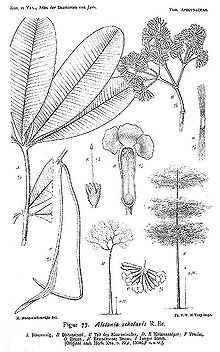Alstonia scholaris
| Alstonia scholaris | |
|---|---|
 | |
| Indian Devil tree (Alstonia scholaris) | |
| Conservation status | |
| Scientific classification | |
| Kingdom: | Plantae |
| (unranked): | Angiosperms |
| (unranked): | Eudicots |
| (unranked): | Asterids |
| Order: | Gentianales |
| Family: | Apocynaceae |
| Tribe: | Plumeriae |
| Subtribe: | Alstoniinae |
| Genus: | Alstonia |
| Species: | A. scholaris |
| Binomial name | |
| Alstonia scholaris L. R. Br. | |
Alstonia scholaris (Apocynaceae, commonly called Blackboard tree, Indian devil tree, Ditabark, Milkwood pine, White cheesewood and Pulai (Bengali:ছাতিম) (Urdu: پھلاہی); syn. Echites scholaris L. Mant., Pala scholaris L. Roberty) is an evergreen, tropical tree native to the Indian subcontinent and Indomalaya, Malesia and Australasia.
Description
_leaves_%26_flowers_in_Kolkata_W_IMG_0534.jpg)



The Alstonia scholaris is a glabrous tree and grows up to 40 m tall, mature bark is grayish and young branches are copiously marked with lenticels.
The upperside of the leaves are glossy, while the underside is greyish.[2] Leaves occur in whorls of 3-10; petioles are 1–3 cm; the leathery leaves are narrowly obovate to very narrowly spathulate, base cuneate, apex usually rounded; lateral veins occur in 25-50 pairs, at 80-90° to midvein. Cymes are dense and pubescent; peduncle is 4–7 cm long. Pedicels are usually as long as or shorter than calyx. The corolla is white and tube-like, 6–10 mm; lobes are broadly ovate or broadly obovate, 2-4.5 mm, overlapping to the left. The ovaries are distinct and pubescent. The follicles are distinct and linear.
Flowers bloom in the month October. The flowers are very fragrant similar to the flower of Cestrum nocturnum.
Seeds of A. scholaris are oblong, with ciliated margins, and ends with tufts of hairs 1.5–2 cm.[3] The bark is almost odourless and very bitter, with abundant bitter and milky sap.
Range
Alstonia scholaris is native to the following regions:[4]
- China: Guangxi (s.w.), Yunnan (s.)
- Indian subcontinent: India; Nepal; Sri Lanka; Pakistan; Bangladesh
- Southeast Asia: Cambodia; Myanmar; Thailand; Vietnam, Indonesia; Malaysia; Papua New Guinea; Philippines
- Australia: Queensland
It has also been naturalised in several other tropical and subtropical climates. Alstonia scholaris (Saptaparni in Bengali) is declared as the State Tree of West Bengal, India
Uses
Alstonia or devil tree or Saptaparni is genus of evergreen trees or shrubs with white funnel-shaped flowers and milky sap. In India the bark of Alstonia scholaris is used solely for medicinal purposes, ranging from Malaria and epilepsy to skin conditions and asthma.
In Ayurveda it is used as a bitter and as an astringent herb for treating skin disorders, malarial fever, urticaria, chronic dysentery, diarrhea, in snake bite and for upper purification process of Panchakarma . The Milky juice of the tree is applied to ulcers.[5]
The bark contains the alkaloids ditamine, echitenine and echitamine and used to serve as an alternative to quinine. At one time, a decoction of the bark was used to treat diarrhoea and malaria, as a tonic, febrifuge, emmenagogue, anticholeric and vulnerary. A decoction of the leaves were used for beriberi.[2] Ayurveda recommends A. scholaris for bowel complaints.
Extracts prepared from the plant have been reported to possess cytotoxic activity. The active compounds include alkaloids and flavonoids present in all parts of the plant. An ethanol extract of the bark of Alstonia scholaris enhanced the anticancer activity of berberine in the Ehrlich ascites carcinoma-bearing mice. This extract also showed cytotoxic activity to HeLa cells.[6][7] It contains echitamine and loganin as major compounds and could potentially be used as an anti-irritation agent.[8]
The wood of Alstonia scholaris has been recommended for the manufacture of pencils, as it is suitable in nature and the tree grows rapidly and is easy to cultivate.[9] In Sri Lanka its light wood is used for coffins. In Borneo the wood close to the root is very light and of white colour, and is used for net floats, household utensils, trenchers, corks, etc.[10]
References
| Wikimedia Commons has media related to Alstonia scholaris. |
- ↑ World Conservation Monitoring Centre (1998). "Alstonia scholaris". IUCN Red List of Threatened Species. Version 2013.1. International Union for Conservation of Nature. Retrieved 19 November 2013.
- ↑ 2.0 2.1 http://www.stuartxchange.org/Dita.html retrieved on 29 June 2007
- ↑ http://www.efloras.org/florataxon.aspx?flora_id=2&taxon_id=200018323 retrieved on 29 June 2007
- ↑ John H. Wiersema. "retrieved on 29 June 2007". Ars-grin.gov. Retrieved 2012-03-30.
- ↑
- ↑ Time to create page: 0.18 seconds. "IN VITRO CYTOTOXICITY ASSAY OF ALSTONIA SCHOLARIS. Misra Chandra Shekhar, Pratyush Kumar, James Joel, Sagadevan Lipin Dev Mundur, Veettil Arun Kumar Thaliyil, V Thankamani". Sciipub.com. Retrieved 2012-03-30.
- ↑ Effect of Alstonia scholaris in Enhancing the Anticancer Activity of Berberine in the Ehrlich Ascites Carcinoma-Bearing Mice. doi:10.1089/1096620041224094. Retrieved 27 May 2013.
- ↑ Lee, Soo-Jin; Cho, Sun-A; An, Su-Sun; Na, Yong-Joo; Park, Nok-Hyun; Kim, Han-Sung; Lee, Chan-Woo; Kim, Han-Kon; Kim, Eun-Kyung (2012). "Alstonia scholaris R. Br. Significantly Inhibits Retinoid-Induced Skin Irritation in Vitro and in Vivo". Evidence-Based Complementary and Alternative Medicine 2012: 1. doi:10.1155/2012/190370. PMC 3170789. PMID 21912567.
- ↑ Tonanont, N. Wood used in pencil making. Vanasarn 1974 Vol. 32 No. 3 pp. 225-227
- ↑ "retrieved on 29 June 2007". Botanical.com. Retrieved 2012-03-30.
Further reading
- USDA, ARS, National Genetic Resources Program. Germplasm Resources Information Network (GRIN) Online Database. National Germplasm Resources Laboratory, Beltsville, Maryland; source url: http://www.ars-grin.gov/cgi-bin/npgs/html/taxon.pl?2688 retrieved on 29 June 2007
